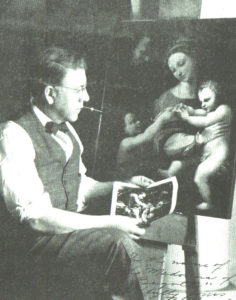The Madonna of Bogotá, as it became known after its rediscovery, might have been taken by the troops of Charles V on the battlefield of Pavia, since it was then in the possession of a cortesan, Margherita Luti, the daughter of a baker known as “La Fornarina” (the “bakeress”). She was a mistress of King Francis I and part of the retinue that accompanied him to the battlefield. It is thought that she obtained the painting from Raphael himself, whose concubine she had also been, as well as the model for two oils of his, La Fornarina and La Donna Velata (Woman with a veil), now at the National Gallery of Antique Art in Rome.

On its voyage to America, the Madonna, now the property of Suárez Rendón, survived a hurricane in the Caribbean, which sunk a frigate of the Spanish fleet carrying slaves, clerics, soldiers, horses, tools and clerks. The fleet found refuge in Cuba, where the vessels were repaired and re-supplied before reaching their destination, the port of Santa Marta in Colombia.
Legend has it that when the painting was unloaded at the dock and freed from the waxed linens which protected it, a dying man who was receiving the last rites from a priest happened to see it and exclaimed: “It is the Mother of God.”
From there the picture undertook the arduous journey on mule-back to the Andes, where, in a way, it played a role in the Conquest, as the centerpiece of an open-air mass held by the Spaniards on the ruins of the Temple of the Sun to commemorate their conquest of the indigenous settlement of Sogamoso. The Spanish Chronicler, Fray Pedro Simón, writes that the Madonna was attributed with the “miracle” of vanquishing the overwhelming number of native forces.
When he found the Madonna in the home of his relative, painter Martínez Delgado gave her some money to undertake technical studies of the painting. The first step was an X-ray examination in a Bogotá clinic in 1938, regarded as a very eccentric procedure at the time. Nevertheless, the plates did show a number of concentric circles underneath the figures and traces of a drawing technique, known as “silverpoint”, typical of Raphael and Leonardo Da Vinci.
At that time, Martínez Delgado was one of the country’s most important painters. He is the author of the mural in the Elliptical Salon of the Capitol in Bogotá, which portrays Colombian founding-fathers Simón Bolívar and Francisco de Paula Santander at the abortive constitutional congress that took place in Ocaña in 1828.
From the moment of its reemergence, the painting provoked a heated controversy in the Bogotá press, the start of what has become known as the “the problem of the Madonna.” A number of art critics and historians held that the work was a mere copy of Raphael´s Madonna of the Rose, now at the Prado in Madrid. Others, however, testified to its authenticity.
Martínez took the picture to New York and Chicago, and in a letter sent to Bogotá, wrote that “among the experts who saw and studied the picture” were “Daniel Catton, Rich A. Sewee, Hubert H. Clarkt [and] Leo A. Marzolo,” the latter of the Chicago Art Institute, who restored it.
The main certification of its authenticity was issued in June 1939 by Ruth Van Sickle Ford, president and director of the Chicago Academy of Fine Arts. “I am absolutely certain that he [Martínez Delgado] possesses an original painting by Raphael,” she wrote. Another certification was issued in March 1940 by the Brooklyn Museum, which likewise vouched for its authenticity.
His son now believes that he lost a fortune of “100 million dollars” for not reaching the bank in time to claim the Madonna of Bogotá, whose journey through the Americas is still not over.
